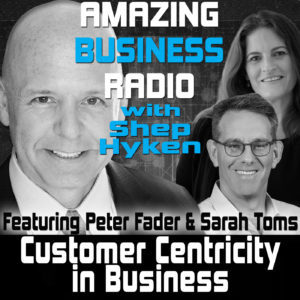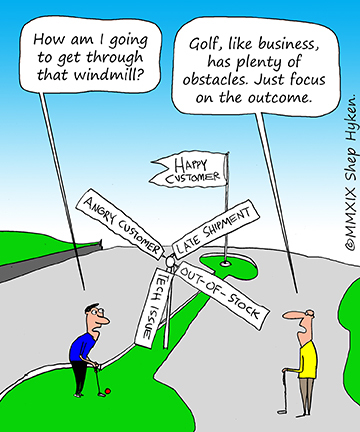Shep Hyken's Blog, page 120
September 9, 2019
5 Top Customer Service Articles for the Week of September 9, 2019
Each week I read a number of customer service and customer experience articles from various resources. Here are my top five picks from last week. I have added my comment about each article and would like to hear what you think too.
When Loyalty Rewards Expire, So Does A Customer’s Loyalty by Dan Gingiss
(Forbes) Rewards programs can be lucrative for loyal customers, but when companies add lots of rules and restrictions to a loyalty program, it can actually have the opposite effect.
My Comment: Let’s start this TOP FIVE roundup with an excellent article about customer loyalty programs. This makes a great point, that when the perks go away, the customer may go away. My take on this is that loyalty programs are actually marketing programs. Most drive repeat business. Nothing wrong with that, but don’t confuse repeat business with true loyalty.
The Pros And Cons Of Instituting A Customer Loyalty Program by Jim Granat
(Forbes) If you decide to reward your customers with a loyalty program, there may be some consequences you haven’t considered. We’ll take a look at some of the pros and cons of instigating a customer loyalty program for your small business.
My Comment: So, on the topic of loyalty programs, this second in our TOP FIVE roundup is a perfect follow-up to the first article in the group. This time, the article covers some of the pros and cons of setting up a loyalty program. If you are thinking of starting a program – and even if you have an existing one – this is an excellent article with some good ideas.
But Does She Have Customer Service Skills? …a fancy resume is just not enough. by Steve DiGioia
(Steve DiGiooa) Every business, whether they sell cars, software, or chicken nuggets is in the customer service business. How we relate to a potential customer takes a skill set that cannot be taught in school or a few specialized programs.
My Comment: The point of this article is simple. If you’re looking for someone who can deliver great customer service, it doesn’t matter if the candidate has an MBA, graduated top in her class or anything else that would make a candidate look impressive. If experience in customer service is not part of her background and her personality isn’t going to fit, all the degrees and high levels of intelligence may not be enough.
In-House vs Outsourced Customer Service: What’s Right for Your Business? by Kim Campbell
(Blue Ocean) Considering outsourced customer service for the first time? It’s likely you already outsource many other areas of your business, but we get it: outsourcing those critical frontline interactions with your customers feels like a whole new ballgame. Which choice is better for your business? Below we discuss the pros and cons of in-house versus outsourced customer service.
My Comment: People often tell me how much they hate customer service that sends the support call overseas – often to a support center that isn’t even run by the company they are calling about. Sometimes the customer knows it, sometimes not. Regardless, a good outsourced customer service organization can be an amazing partner to the company. A customer shouldn’t notice a difference. It should be a seamless brand experience. So, let’s assume the outsourced department is really good. Why could a company benefit from outsourcing their service? This short article will give you some answers.
3 in 10 Americans would rather watch paint dry than be put on hold by Zoya Gervis
(New York Post) Having to stay on hold for too long, being transferred multiple times and dealing with grumpy employees are just some of the poor customer service experiences Americans deal with, according to new research.
My Comment: I like an article full of stats and facts to make the point. Here are some strong facts surrounding the good and bad of customer service. It’s hard to believe (but it’s true) that there are still rude customer service reps. Some rudely hang up on customers. Some just deliver poor service – often appearing not to care. In an era where customer service and CX are paramount to the success of an organization, why wouldn’t some of these companies, who are recognized for poor service, step up and just meet the customer’s expectations? Here is some fun reading with survey stats that will make you think.
 Shep Hyken is a customer service expert, professional speaker and New York Times bestselling business author. For information on The Customer Focus
Shep Hyken is a customer service expert, professional speaker and New York Times bestselling business author. For information on The Customer Focus customer service training programs go to www.TheCustomerFocus.com. Follow on Twitter: @Hyken
customer service training programs go to www.TheCustomerFocus.com. Follow on Twitter: @Hyken
The post 5 Top Customer Service Articles for the Week of September 9, 2019 appeared first on Shep Hyken.
September 6, 2019
Guest Blog: Mobile, Frictionless and Secure – The Experience Consumers Expect
This week we feature an article by Christina Lutrell about understanding the shifting consumer experience while maintaining your customer’s trust.
As we know, consumer experience and expectations have changed rapidly in response to new technologies, market forces and security concerns. With an increasing number of high visibility data breaches every year and mobile playing a more prominent role in everyday transactions, consumers are not only becoming more aware and involved in protecting their identities but also demanding more secure, easy and seamless transactions.
Understanding the shifting consumer experience related to security, convenience and speed is key to providing great customer service and ensuring loyalty and engagement, while establishing trust.
Recently released, IDology’s Second Annual Identity Consumer Study sheds light on the latest consumer experience trends and the impact they’re having on businesses.
Mobile-first and Mobile-only Mindsets
Mobile-first is not a new concept, but as a growing number of consumers flock to open accounts on mobile devices instead of computers, businesses need to start thinking about mobile-only experiences. The study revealed that, for the first time, Americans opened more new accounts online on mobile devices (61%) than on computers (56%) over the past 12 months, and 20 percent of consumers registered for new accounts exclusively on mobile devices, an increase of 10 percent compared to last year.
From a business perspective, mobile gives potential and existing customers the ability to onboard and transact wherever, whenever. However, to ensure customer, businesses need to create superior mobile experiences while also making mobile security and validation a priority.
Fast, Easy and Secure
Consumers expect the mobile experience to be seamless, secure and fast – otherwise, they quickly abandon account enrollment: 37 percent of consumers abandoned a signup process in the past 12 months because it took too long or difficult and for less than half (43%) of consumers, the account signup processes they experienced on their smartphones were “extremely” or “very” easy.
Especially during mobile interactions, each additional step a business puts between itself and a consumer creates friction that can have a negative impact on customer acquisition and service. To prevent friction during mobile account signup, businesses should consider new technologies that can improve and simplify the process and allow them to deploy dynamic escalation methods only when needed.
We learned from the study that consumers are open to using technologies that prefill their information. Beyond prefill, 34% were open to mobile document capture. Using a picture of a driver’s license to pre-populate a form or verify an identity is a relatively new approach with a variety of potential applications. In the last 12 months, more than 50 million Americans submitted a picture of their license through their smartphone as part of an identity verification process. Businesses not offering this option could be adding unnecessary friction and time to the process.
Employing a multi-layered approach to identity proofing that leverages various types of authentication and offers the right amount of friction at the right time can elevate customer trust, facilitate onboarding, increase business identity assurance and shut down fraud.
Security and Identity Protection Expectations
The study also showed that consumers are more concerned about protecting their own personal information, with an increase in the past year of 15 percent who strongly feel it’s their personal responsibility. Consumers also expect businesses to do more to protect their personal data. Seventy-eight percent strongly believe that organizations need to protect their information, an increase of 16 percent.
These data points show us that because consumers are increasingly concerned of the security of their data, trust assurance is highly important for the consumer experience: with higher trust comes loyalty.
By deploying more advanced and robust identity verification and authentication processes, companies can elevate consumer trust, unlock more value and gain a competitive edge, both in the user experience on the front-end and risk mitigation on the back-end.
To accomplish this, companies need flexible identity verification and authentication that improve the customer experience through a layered approach that employs behind-the-scenes technology, consortium data and machine learning to identify consumers with minimal friction.
Christina Luttrell is the Chief Operating Officer for IDology , a GBG company and leader in multi-layered identity verification and fraud prevention. In her 10 years at IDology, Luttrell has significantly advanced the company’s technology, forged close relationships with customers and driven the development of technology innovations that help organizations stay ahead of constantly shifting fraud tactics without impacting the customer experience.
For more articles from Shep Hyken and his guest contributors go to customerserviceblog.com.

Read Shep’s latest Forbes article: The Real Reason Shoppers Aren’t Returning
The post Guest Blog: Mobile, Frictionless and Secure – The Experience Consumers Expect appeared first on Shep Hyken.
September 4, 2019
The De-Evolution of a Business
 Not long ago I was with my friend, Nelson Griswold. He shared with me a phenomenon he referred to as the de-evolution of a business. It can mean the beginning of the end for a business, and it usually comes as a result of not listening to the company’s customers.
Not long ago I was with my friend, Nelson Griswold. He shared with me a phenomenon he referred to as the de-evolution of a business. It can mean the beginning of the end for a business, and it usually comes as a result of not listening to the company’s customers.
This pattern mirrors one found in the entertainment business—the four stages of an actor. Let’s say our actor’s name is John Smith. Four questions and statements sum up what I’m talking about:
At the unknown stage of his career, the question is: “Who is John Smith?”
Once he is discovered and becomes a sensation, the director makes a request: “Get me John Smith.”
He retires but is remembered. The new request is: “Get me someone like John Smith.”
One day, not too many years later, few people remember his career and we’re back to the question: “Who is John Smith?”
It’s the same in business. My friend Nelson Griswold refers to this business life cycle as the de-evolution of a business. It’s based on what experts refer to as the four stages of a business:
Start-Up: This is where few people, if any, know who you are.
Growth: This is a very exciting stage as the business is growing—hopefully booming.
Maturity: At this stage, everyone is comfortable. However, there is little—if any—growth.
Decline: Without growth, you risk becoming irrelevant to your customers. This is the beginning of the end.
Nelson feels that a mature business starts to decline when its leadership stops listening to their customers. They miss opportunities, don’t pay attention to feedback, make up excuses for why the company is performing badly and basically turn a blind eye to reality.
It’s the goal of every business to be successful. Getting to a state of maturity can be dangerous. Staying in growth mode, even if it is moderate, is the ideal. Growth needs to happen in two places. The first is product—what the company sells. We’ll assume it is a good product that customers want to buy. The second is the customer experience. This is the area with the highest risk. Innovation must take place to keep both the product and the customer experience relevant.
I can’t do much in the way of product advice, but you need to make sure it stays desirable. What I can share is that innovation in the customer experience is just as important as product innovation. What will set you apart from your competition is the service and experience you provide. Experience innovation is the secret. Ask yourself these two questions: What are you doing to escalate and grow your business? What are you doing to stay relevant?
Shep Hyken is a customer service expert, keynote speaker, and New York Times bestselling business author. For information, contact 314-692-2200 or www.hyken.com. For information on The Customer Focus customer service training programs, go to www.thecustomerfocus.com. Follow on Twitter: @Hyken
customer service training programs, go to www.thecustomerfocus.com. Follow on Twitter: @Hyken
(Copyright © MMXIX, Shep Hyken)
The post The De-Evolution of a Business appeared first on Shep Hyken.
September 3, 2019
Amazing Business Radio: Peter Fader & Sarah Toms
 Customer Centricity in Business
Customer Centricity in BusinessBuilding a Customer-Centric Company with Long-Lasting Value
Shep Hyken interviews Peter Fader and Sarah Toms. They discuss their new book, The Customer Centricity Playbook, and the “Customer Centricity Manifesto,” which teaches individuals and organizations how to build a customer-centric culture.








The Interview with Peter Fader & Sarah Toms:
A key term is CLV, which stands for “customer lifetime value.” Taking this into account, it is almost always more profitable to retain existing customers versus acquiring new customers.
There are high-, mid- and low-value customers. In your customer base, there are fewer high-value customers and losing them could drastically, negatively impact your business profits. There are more low- and mid-value customers. They are easier to acquire and losses don’t hurt your business as much.
The paradox of customer-centricity is that despite these facts, many companies still expend a lot of effort into acquiring and retaining the risky high-value customers rather than retaining the dependable low- and mid-value customers. Be careful with how you manage your customer base.
Don’t prioritize price over customer experience. Focus your efforts into creating a valuable experience first and foremost, and you will find that a loyal and profitable customer base will follow.
Wait to create loyalty programs until you learn more about your customer base, their spending habits, and their wants and needs. Also, assess the kinds of customers you’re attracting from your marketing campaigns. Then build your loyalty program using this data.
Most loyalty programs are really marketing programs. For instance, “Buy nine and the tenth one is free!” True loyalty involves an emotional connection.
Customer heterogeneity refers to differences between customers. You must recognize these differences and not attempt to create a one-size-fits-all approach to use across your entire customer base. Celebrate the differences that elevate your customers above “average.”
The Customer Centricity Manifesto consists of four major areas:
Customer Heterogeneity
Cross-Functional Uses of CLV
Metrics That Reflect Customer Equity
Clear Communications with External Stakeholders
Quotes:
“Be careful with how you manage your customers. Make sure that you’re not accidentally firing your customers. That’s not what customer-centricity is about.” – Sarah Toms
“Recognize the heterogeneous nature of your customer base and don’t create a one-size-fits-all approach.” – Sarah Toms
“When it comes to your customers, don’t celebrate averages. Celebrate differences.” – Peter Fader
About:
Sarah Toms is the executive director and co-founder of Wharton Interactive. She works with The Women in Tech Summit and techgirlz.org to support women and girls in the technology field. Recently, she co-authored The Customer Centricity Playbook with Peter Fader.
Peter Fader is a professor of marketing at the University of Pennsylvania’s Wharton School. He is the author of Customer Centricity: Focus on the Right Customers for Strategic Advantage. Recently, he co-authored The Customer Centricity Playbook with Sarah Toms.
Shep Hyken is a customer service and experience expert, New York Times bestselling author, award-winning keynote speaker, and your host of Amazing Business Radio.
This episode of Amazing Business Radio with Shep Hyken answers the following questions … and more:
What is customer-centricity?
How can I be customer-centric?
How can I create customer loyalty?
Does price matter more to customers than experience?
How can I use data analytics and metrics to improve my CX?
The post Amazing Business Radio: Peter Fader & Sarah Toms appeared first on Shep Hyken.
September 2, 2019
5 Top Customer Service Articles for the Week of September 2, 2019
Each week I read a number of customer service and customer experience articles from various resources. Here are my top five picks from last week. I have added my comment about each article and would like to hear what you think too.
The #1 Guide To Customer Experience Conferences in 2020 by Krishna Charan
(Feshdesk) To help you figure out which events to attend, we have curated a region-wise list of top customer experience conferences around the world. This exhaustive guide offers key details to plan your conference calendar, including event descriptions that help you choose which ones are most relevant to you.
My Comment: Every wonder what customer service and customer experience conferences to attend. I’m asked on a regular basis which ones I would recommend. Our friends at Freshdesk have done us a favor and listed 30 conferences throughout the world that you may want to consider attending. A great resource!
Focusing On Customer Experience Is No Longer Optional by Chris Cancialosi
(Forbes) Ready or not, the customer experience (CX) game is on. No matter what size or industry you may play in, you are now competing based on the experience you provide to your customers.
My Comment: Another article that makes the case for why all organizations need to focus on their customer experience strategy. If not, be prepared to catch up – if you can! As it states in the title of the article, “CX is no longer optional!”
The CX Superheroes Amongst Us by Katie Watson
(SentiSum) Customer Experience Superheroes are becoming a prominent part of the workforce. At M.I.C.E (Military Intelligence of Customer Experience) we have performed a detailed surveillance of the three supernatural customer experience managers known to us.
My Comment: If you’re into superheroes, then you are going to enjoy this fun article. M.I.C.E (Military Intelligence of Customer Experience) has identified three customer experience super-hero managers; Gut Insect, Manual Man and Captain Insight. The author shares the strengths and weaknesses of each. Which one of these super-heroes are in your organization?
Debunking Automation Myths In Customer Support by Anand Janefalkar
(Forbes) Since the early days, innovation and automation have transformed the way companies provide products or services to their customers. Today, automation is omnipresent, and it continues to change not only work but also the fundamental ways we live and interact with one another.
My Comment: Have you wondered just how far AI (artificial intelligence) and IA (intelligent automation) have impacted customer service? A Gartner survey claims that by 2023 more than 40% of customer service will be automated. That’s up from 25% in 2018. What about customer service jobs? Will they be eliminated? Anand Janefalkar, CEO of UJET, “debunks” three myths, including the one that claims that human customer service will be eliminated.
Improve Employee Experience to Improve Customer Experience by Jeannie Walters
(Experience Investigators) The employee experience can feel hard to manage. As leaders, we ask our employees to care about a lot of things, even those that are only tangentially related to their job descriptions. As an industry, we’re overwhelming employees with messages about the next big thing they need to learn.
My Comment: I’ve said it many times (including in this weekly column), what’s happening on the inside of your organization will be felt on the outside. This article is all about culture. Jeannie Walters, customer service expert, takes a look at why some companies struggle to get their employees in alignment with their customer service vision. It starts by understanding what we are asking our employees, and what kind of experience we are creating for them.
 Shep Hyken is a customer service expert, professional speaker and New York Times bestselling business author. For information on The Customer Focus
Shep Hyken is a customer service expert, professional speaker and New York Times bestselling business author. For information on The Customer Focus customer service training programs go to www.TheCustomerFocus.com. Follow on Twitter: @Hyken
customer service training programs go to www.TheCustomerFocus.com. Follow on Twitter: @Hyken
The post 5 Top Customer Service Articles for the Week of September 2, 2019 appeared first on Shep Hyken.
August 30, 2019
Guest Blog: How Should You Grow and Sustain Your Customer Lifetime Value?
This week we feature an article by Lukas Sitar who writes about growing and sustaining customer lifetime value for the entire customer cycle.
 While many marketers look at metrics like conversion rates, net profit per sale, average value of a lead, and average customer order, they often overlook their customer lifetime value. This is a metric that allows you to compete with your biggest competitors, establish longevity in your marketplace, and allow you to maximize the effectiveness of your marketing campaigns.
While many marketers look at metrics like conversion rates, net profit per sale, average value of a lead, and average customer order, they often overlook their customer lifetime value. This is a metric that allows you to compete with your biggest competitors, establish longevity in your marketplace, and allow you to maximize the effectiveness of your marketing campaigns.
But just what is customer lifetime value? It’s simply the average profit you’ll generate with your customers over the lifetime of the relationship. By working to increase your customer lifetime value, you can afford to spend more on advertising, out-market competitors, and increase company profits.
The challenge really lies in growing customer lifetime value. Most marketers focus on maximizing the profits from the initial sale, but how do you grow and sustain customer lifetime value for the entire customer cycle?
How to Start the Process of Growing Your Customer Lifetime Value
The first thing you want to do is go after the low-hanging fruit opportunities to increase your customer lifetime value. You want to look at how to increase your average order value and profits by testing different up-sell and cross-sell offers. Don’t assume that your current sales process is good the way it is. Try to optimize your initial sales process as best as you possibly can.
Some ideas for increasing your average order value and profits are to test various bundle deals, offer free shipping for spending a certain amount of money, and explaining why your cross-sell and up-sell offers are valuable to the customer. Most companies tell their customers about other products and services related to their purchase, but fail to mention why these products and services are valuable.
How Huge Growth Can Be Achieved with Customer Segmentation
The next step to growing your customer lifetime value is to start segmenting your customers. There will always be different types of customers for your products and services. This eye-opening case study states that “segmentation has been vital to the success of NIVEA Sun and allowed the brand portfolio to grow to over 40 products.” It shows that Nivea segmented their sun protection products by gender, skin tone, and even age group.
You have to do the same for your products and services. By segmenting your customers into different groups and understanding how these groups differ, you’ll be able to identify product opportunities and create more effective marketing campaigns. For instance, a guitar manufacturer will be able to send targeted offers to customers that listen to hard rock and different offers to customers that listen to blues. It would be far less effective if a generic offer was sent to both customer segments.
Build Engagement and Establish Relationships with Valuable Content
In order to grow your customer lifetime value, there needs to be a connection with your customers. It’s easy for your customers to forget about you when you’re not making an effort to stay in touch with them. The best way to build and maintain this connection is through valuable content.
By producing valuable content and distributing it through channels like your blog, email, social media accounts, and even SMS, you’ll start to build engagement with your customers. If you do this on a continuous basis, you’ll establish strong relationships with your customers due to the value you’ve been giving them. This will make them more receptive to your future offers.
Sustain Your Customer Lifetime Value Through Exceptional Customer Service
How do you get your customers to keep coming back? How do you get them to stay loyal to your business? The answer is to simply provide outstanding customer service. As a matter of fact, 97 percent of consumers say customer service is a big factor when it comes to brand loyalty. But when most companies think about customer service, they think that it just comes down to responding to customer complaints.
Customer service is about more than that. It’s about going the extra mile to resolve customer problems. It’s about sending them free gifts when least expected. It’s about offering deals that are exclusive to them. It’s about listening to customer feedback and actually implementing customer suggestions.
In fact, the same source showed that 89% of consumers switched to another business after experiencing poor customer service. This means that you cannot ignore customer service if you’re serious about increasing customer lifetime value.
Manage Your Customer Lifecycle Properly to Maximize Opportunities
To sustain your customer lifetime value, you also need to manage the customer lifecycle. This basically means the various stages customers go through from becoming new customers, making additional purchases two to three months in, to becoming loyal customers. Proper customer lifecycle management means reaching out to customers in the right manner according to their current lifecycle stage.
In order to make the right decisions, you’ll also need proper customer data management. You want to have access to advanced customer data that will give you a clear perspective of what kind of stage your customer is in, what kind of products/services the customer has bought, what channels they’re using, what pages they’ve visited, and more. You need to look beyond everyday metrics like average order value and customer lifetime value to make the best marketing decisions and get the most value from your customers.
Create Loyalty Programs with Enticing Rewards
Another excellent way to sustain customer lifetime value is to create a loyalty program. Loyalty programs incentivize customers to continue doing business with you because there’s a strong incentive to do so. Loyalty programs are typically run using point or credit systems which can be redeemed as discounts for future purchases.
The problem with most loyalty programs is that the incentives are far from enticing. All they do is offer small discounts for loyal customers. To keep customers coming back long after their first purchase, you need to make sure your loyalty program is actually rewarding.
This means your loyalty program has to offer enticing, exclusive offers to your most loyal customers. This doesn’t necessarily mean steep discounts – it could also be unique experiences, higher levels of service, limited edition products, or access to members’ only clubs. Some hotels and airlines are particularly good at creating these types of loyalty programs. Leverage your product or service to create value for your most loyal customers, and your loyalty program will be successful.
Conclusion
To sum up, you need to focus on your lifetime customer value to compete. There are many ways to go about growing and sustaining your lifetime customer value. A big part of the solution lies in using intelligent customer data platforms that can help you collect important data and act on that data effectively.
Lukas Sitar is the SEO and Inbound Marketing Specialist contracted with Exponea – Customer Data Platform, where he prepares the B2B SEO content strategy. Lukas’ main focus is to increase the number of sales-qualified leads generated from organic traffic, which he achieves by improving the UX, technical and on-page SEO aspects of Exponea’s website.
For more articles from Shep Hyken and his guest contributors go to customerserviceblog.com.

Read Shep’s latest Forbes article: Five Questions That Help Define Your Culture
The post Guest Blog: How Should You Grow and Sustain Your Customer Lifetime Value? appeared first on Shep Hyken.
August 28, 2019
It’s Not Where You Are. It’s Where You’re Going.
 Sometimes you find life lessons in unexpected places. This time it was on the golf course. Almost every Sunday throughout the summer I play golf with some great guys. One Sunday we decided to play the championship tees—meaning we hit from the furthest point away from each hole. Obviously, this makes the game longer and harder. The extra distance usually translates into taking a few more swings at the ball than normal.
Sometimes you find life lessons in unexpected places. This time it was on the golf course. Almost every Sunday throughout the summer I play golf with some great guys. One Sunday we decided to play the championship tees—meaning we hit from the furthest point away from each hole. Obviously, this makes the game longer and harder. The extra distance usually translates into taking a few more swings at the ball than normal.
One of our players was nervous, as he doesn’t typically hit the ball as far as the rest of us. We started by telling him to not let the extra distance bother him—play his regular game. Don’t swing harder because it’s longer; just relax and play like usual. On his first swing, he hit a beautiful drive that landed in about the same place as he usually lands from the closer tees. A few holes later we were hitting over water. It was obvious he was nervous again because he wasn’t sure he could clear the water to land on the fairway. That’s when it helps to play golf with a “motivational speaker” (that’s me). I smiled and said:
“It’s not where you’re hitting from. It’s where you’re going to. Think about where you want to land, not where you don’t want to land.”
He smiled and swung at the ball. Not only did he clear the water, but he also landed dead center on the fairway. He jokingly said, “I guess the motivational ‘stuff’ really works!”
I realized that the comment was good—not only in golf but in all areas of life. Don’t get hung up on where you are now. It’s more about where you’re going. That’s what you need to concentrate on: your destination.
How does this apply to customer service? When dealing with an upset customer or contentious situation, you are in the moment. To tie it into the golf metaphor, that moment is where you’re hitting from. You must manage that experience, but you also must think about the future, which is where you’re hitting to.
What’s the perfect outcome? How does the customer feel now? That’s where you’re hitting from. How do you want this customer to feel when you finish your conversation? That’s where you’re heading. Knowing that will free you up to think about what needs to be done to get to the resolution that will make your customer happy. It will allow you to focus on the journey that will lead you to customer satisfaction.
It’s too easy to get caught up in the emotion of the moment. It could be an angry customer. It could be a process that’s gone wrong. Regardless, it’s not optimal. It’s a problem or obstacle that must be overcome. Take a swing at the ball, metaphorically speaking, and focus on where you want it to land.
Shep Hyken is a customer service expert, keynote speaker, and New York Times bestselling business author. For information, contact 314-692-2200 or www.hyken.com. For information on The Customer Focus customer service training programs, go to www.thecustomerfocus.com. Follow on Twitter: @Hyken
customer service training programs, go to www.thecustomerfocus.com. Follow on Twitter: @Hyken
(Copyright © MMXIX, Shep Hyken)
The post It’s Not Where You Are. It’s Where You’re Going. appeared first on Shep Hyken.
August 27, 2019
Amazing Business Radio: Chris Bauserman
 The Emotional Customer Experience
The Emotional Customer ExperienceUnderstanding the Emotion Behind the Experience Economy
Shep Hyken interviews Chris Bauserman. They discuss how emotions and personalization play a large role in the customer service and experience of today, and how we can use data analytics to harness that knowledge for improvement.








The Interview with Chris Bauserman:
The experience economy has changed dramatically over time. Today, who we choose to do business with has much more to do with emotion than with products, technology, or even price point. The companies that differentiate themselves through their service are the ones that stand out and succeed.
What is the difference between customer service and customer experience? Customer service is part of the customer experience. Bad service can cause a customer to walk out on you and your company, but it’s not the only factor anymore. You must ensure as much as you can that the customer’s entire journey with you is a positive one.
A customer may begin their journey with you in a variety of different ways. What matters most to them, in the end, is that you know them, have their best interests at heart, and resolve their issue quickly.
There is a difference between multichannel and omnichannel. They both allow customers the choice of how they want to connect with you, but omnichannel allows for a seamless connection between platforms, which is a crucial element in creating a frictionless, convenient experience. The most important thing is making yourself available to customers on their terms.
91% percent of consumers desire a frictionless, convenient experience, but less than a quarter of business focus on or provide that for their customers. This huge disconnect needs to be addressed. Design your customer journey in a way that is truly customer-centric.
Be proactive as much as you can. It’s important to provide a fast and easy resolution to a problem, but it’s even better if you can avoid that problem altogether before it becomes an issue or the customer becomes aware of it.
Contact centers are a wealth of information. AI and data analytics can help you measure and understand the emotions of the customers and employees to identify the root of common problems. From there, you can make changes and improve, creating a better experience for everyone involved.
Quotes:
“Move to a digital-first mentality. Make it easy for customers to reach you and for agents to do a great job serving them digitally.” – Chris Bauserman
“Your customer experience is your product.” – Chris Bauserman
“It’s not just the product you offer; it’s how you make your customers feel.” – Chris Bauserman
About:
Chris Bauserman is the VP of Product and Segment Marketing at NICE InContact. He has over 20 years of experience helping companies improve their customer service.
Shep Hyken is a customer service and experience expert, New York Times bestselling author, award-winning keynote speaker, and your host of Amazing Business Radio.
This episode of Amazing Business Radio with Shep Hyken answers the following questions … and more:
What is the experience economy?
What is the difference between customer service and customer experience?
What do “omnichannel” and “multichannel” mean?
What is the difference between omnichannel and multichannel?
How can I use AI and data analytics to improve my customer service?
How can I be proactive in my customer service?
The post Amazing Business Radio: Chris Bauserman appeared first on Shep Hyken.
August 26, 2019
5 Top Customer Service Articles for the Week of August 26, 2019
Each week I read a number of customer service and customer experience articles from various resources. Here are my top five picks from last week. I have added my comment about each article and would like to hear what you think too.
37 Customer Experience Statistics You Need to Know for 2019 by Toma Kulbytė
(Super Office) Customer experience has fast become a top priority for businesses and 2019 will be no different. But, why are so many companies focusing on the customer experience and what happens to companies that choose to ignore it?
My Comment: We start this week’s Top Five roundup with an article filled with stats – 37 of them! Sure, you may already know how important customer service and experience are, but just a reminder that 86% of customers are willing to pay more for a great experience. And 65% of customers find a positive experience to be more influential than all that money invested in great advertising. Now you only have 35 more to read!
5 Strategies On How To Stay Ahead Of Customer-Driven Disruption by NJ Goldston
(Forbes) Sarkar details five strategies that any company can adapt in their own push to connect with, and capitalize on, customer needs. See how many of them your company is currently executing or what you should be adding to your project list.
My Comment: As I read this article I thought about the companies that have disrupted their industry – or even just their competition. How do we defend against disruption? Consider that maybe it’s not the competition, but us doing what we’ve always done – even if it always worked. Here are some good ideas and reminders. My favorite strategy is the fifth one, which tells us to disregard the first four (even if they always worked). You see, once something is working, you must find a way to change it up and make it better. Otherwise, someone will come along and disrupt you.
Customer Service Challenges the Industry Will Face in 2020 and Beyond by Cory Hedgepeth
(CustomerThink) There are few more perennial business challenges than customer service. When competition is rife, customer service makes or breaks your business. All things being equal (and they often are), your ability to resolve customer concerns promptly and considerately is the difference between your business swimming or sinking.
My Comment: This is a glimpse into the future… as in next year. The speed at which business is moving can be overwhelming at times, but you must keep up. Here are some ideas and trends you must consider. Basics, such as avoiding slow response times, to cutting edge ideas incorporating blockchain into the customer experience.
How to Handle Difficult People (and Still Achieve Your Business Goals) by Aytekin Tank
(Entrepreneur) A founder’s guide to effectively utilizing feedback — even from impossible-to-please, difficult people.
My Comment: It’s never fun to deal with difficult customers. There are thousands of articles out there on how to deal with them. (I’ve written a number of them!) So why include another one in this roundup? There was a concept the author covered that intrigued me; distinguishing between a difficult message and a difficult person. There’s a big difference.
Are You Meeting & Exceeding Customer Expectations? by Teresa Allen
(Teresa Allen) My new customer service keynote, A 2020 Service Strategy to Grow Your Business focuses on 5 specific strategies. Today’s article focuses on Step ONE. Evaluate what your organization needs to do to implement these important steps moving toward 2020.
My Comment: Teresa Allen lays out ten major expectations that your customers are expecting, and if you want to keep your current customers, you must meet, if not exceed, these expectations. Even the author admits they may seem basic, but she suggests to “read between the lines,” and you should. These are the ways to keep a competitor from disrupting your business and stealing away your customers.
 Shep Hyken is a customer service expert, professional speaker and New York Times bestselling business author. For information on The Customer Focus
Shep Hyken is a customer service expert, professional speaker and New York Times bestselling business author. For information on The Customer Focus customer service training programs go to www.TheCustomerFocus.com. Follow on Twitter: @Hyken
customer service training programs go to www.TheCustomerFocus.com. Follow on Twitter: @Hyken
The post 5 Top Customer Service Articles for the Week of August 26, 2019 appeared first on Shep Hyken.
August 23, 2019
Guest Blog: Omnichannel Customer Service – Why should you implement it in your business?
This week we feature an article by Martin Frascaroli who talks about why it is important to meet your customer needs using omnichannel customer service.

Your potential customers want to buy quickly and comfortably through an integrated experience. They sign in from different devices and communicate through all available means. They are real-time users looking for a rewarding shopping experience, and they expect the best service.
How can you meet these potential consumers’ needs? The answer is in Omnichannel Customer Service, and we’ll tell you why.
The new consumer profile in the digital age
Customers used to go to a physical store to see products, check prices and make purchases. Today, they shop digitally through different channels. This means that customers can check your product’s features on social media, request prices via email, and purchase through your sales chat. In fact, according to a Zendesk study, 67% of online shoppers have made purchases in the past six months that have involved multiple channels.
This new way of shopping has led companies to offer multiple contact channels as a means for survival in today’s market. And this is not entirely wrong. It’s very important to respond to your customers’ needs through different channels, but it’s useless if you don’t have a strategy to coordinate and organize those interactions.
Omnichannel solution: the key to efficient communication
There’s one need that is still among us despite constant changes: customers want an integrated shopping experience. They expect you to meet their needs and demands even when they use different channels to communicate. And this is where the omnichannel solution comes into play.
Omnichannel Customer Service, especially when powered by Artificial Intelligence, integrates all communication channels of a company making its interaction with the customer easier. The goal is to provide a consistent service so that the user doesn’t notice differences, overlapping or errors between the channels.
This means that the data collected from all customer interactions are centralized in a single database allowing the company to provide comprehensive and consistent service through all channels. With an omnichannel solution, you can know which channel the customer has used to contact the company in the past, what type of interaction it was and which products or services they purchased.
Omnichannel Customer Service considers customers as unique individuals, analyzes their records, understands how they interact and knows their interests and preferences. This allows you to customize each user’s experience with the brand and to anticipate their needs.
Advantages of an omnichannel experience
The following are some of the main advantages of an omnichannel experience:
Customer Service for all users
Some customers will prefer to communicate with your company through online chat or email. Others will choose self-service alternatives like forums and FAQs. And there are those who still prefer social media or even being contacted by phone. These different profiles require a service that adapts to their needs and is always ready to assist them through their preferred channel. An omnichannel solution is the best way to achieve this.
Fast response
Time is a key factor for ensuring a positive user experience with your brand. Omnichannel service has a strong impact on immediate responses. It can provide solutions for the user in just a few seconds. Therefore, it’s an excellent feature for increasing sales: the faster you provide information, the greater the likelihood the customer will make a purchase.
Customer retention
If the service meets your customers’ expectations, they will be more satisfied with your company — and satisfied consumers buy more. According to a report by Harvard Business Review, a 5% increase in customer retention may mean an increase of up to 95% in a company’s annual earnings. The flexibility offered by an omnichannel experience can be a great ally for your company’s growth.
Data collection
Storing your customers’ data in a single place helps with predictive analysis, allowing you to make more focused and assertive strategic decisions. Moreover, it’s a great source of information about your current customers and your potential buyers. Having this information at hand will help you develop very efficient Marketing and Sales initiatives.
Conclusion
Consumer behavior is constantly evolving. Therefore, adapting to the new ways of establishing a relationship with them is essential.
Remember that an omnichannel strategy focuses on your customer’s current needs, so you must be easily and quickly available, at all times and through all channels.
With Omnichannel Customer Service, you will encourage successful user experiences, exceed your customers’ expectations and improve your brand’s reputation, resulting in amazing outcomes for your company.
Martin is a self-made entrepreneur with over 14 years of experience at the forefront of customer service, marketing, AI and technology. He is the founder of Aivo, a customer service software provider powered by Artificial Intelligence.
For more articles from Shep Hyken and his guest contributors go to customerserviceblog.com.

Read Shep’s latest Forbes article: The Most Convenient Guitar In The World
The post Guest Blog: Omnichannel Customer Service – Why should you implement it in your business? appeared first on Shep Hyken.



